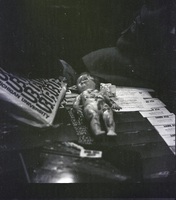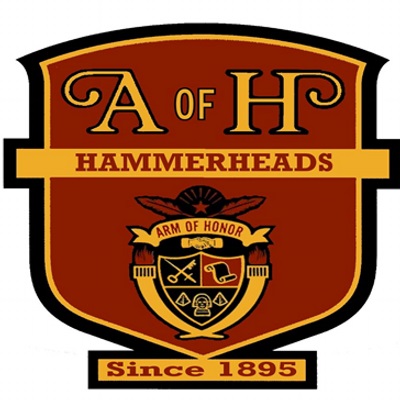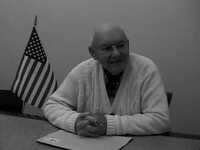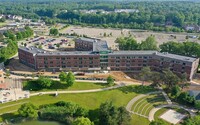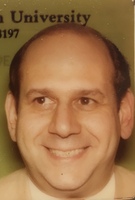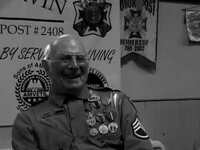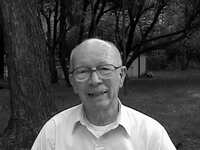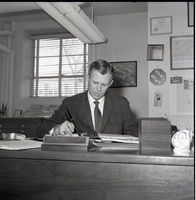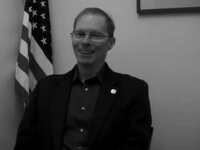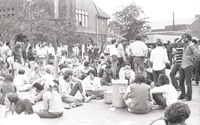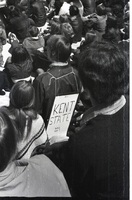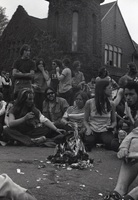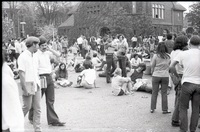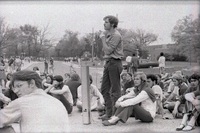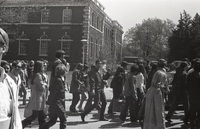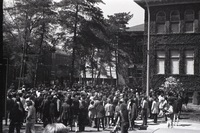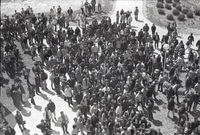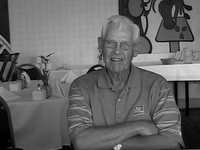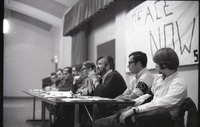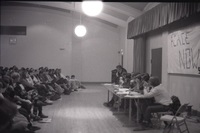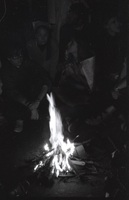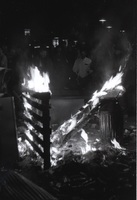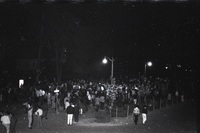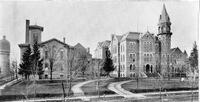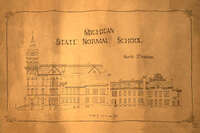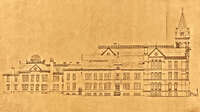Search
6 item sets
530 items
-
In the Fall of 2022, Matt Jones’s Oral History Techniques class conducted a set of interviews documenting the stories behind the student unrest on Eastern Michigan University’s campus from 1966-1972. Ken Moon was a Black administrator at EMU during the lates 1960s and early 1970s, and an important mediator between the students and the administration. Moon was an influential figure on campus and supported students academically and personally.
-
Kenneth Stevens served with the Communication and Theater Arts Department -currently Communication, Media, and Theater Arts Department- from 1973 until his retirement in 2014. During that time, Stevens created the graduate and undergraduate programs in Arts Management, directed hundreds of plays and musicals, was a ten-time winner of the faculty recognition awards, received the EMU Gold Medallion Award, and the Teaching Innovation Award. Outside of teaching at EMU, Stevens has also served as Associate Director of the Cherry County Playhouse in Traverse City, producer at the Red Barn Theater in Saugatuck, MI, as well as Director of the Actors Repertory Theater in Las Vegas, and President of the Michigan Theater Association.
-
A photograph of the SDS protest at the ROTC station in McKenny Hall.
-
While enrolled as an undergraduate at the Michigan State Normal School (now Eastern Michigan University) in Ypsilanti, Michigan, Mr. Kettles was drafted into the United States Army in October of 1951. Commissioned as a Lieutenant after completing Army Flight School in 1953, Mr. Kettles was sent to Korea, but only after the conflict had ended. After returning to the United States, Kettles served in the Army Reserve until he volunteered for active duty service in Vietnam in 1963. In May of 1967, Kettles was directly responsible for saving the lives of 44 American soldiers who were ambushed by North Vietnamese forces. Serving a second tour of duty in 1969, Mr. Kettles returned to United States in 1970 to work with combat readiness for Army Reserve and National Guard units in Texas. Mr. Kettles was discharged from the U.S. Army in 1978, and went on to finish his degree at what was then Eastern Michigan University. Completing a master's degree at Eastern Michigan University a short time later, Kettles would come to teach at Eastern Michigan University himself and was the force behind the schools Aviation Management program. In 2016, Charles Seymour Kettles was awarded the Medal of Honor by President Barack Obama for his heroism in saving the lives of those 44 service members in May of 1967.
-
Kirk Profit was an active member of the Arm of Honor from 1970 until 1975. Son of University Controller Louis Profit, Kirk Profit was a student at Roosevelt School until its closing in 1969 when he moved to Ypsilanti High School. Profit details some of the physical changes to campus since his student days, and the more familial aspect of campus in the 1950s and 1960s. Profit speaks of his father's friendship with President Harold Sponberg, and the need to keep a low profile during the tumultuous days on campus in the late 1960s. Profit describes fraternity living, and the pursuit of the All Sports Trophy, given to the most decorated fraternity in intramural sports. Profit discuesses fraternity initiation and taking clandestine drives to Silver Lake to try marijuana. Profit walks the reader through the Arm house, explaining the orgins for many of the room names.
-
Owen enlisted in the Marine Corps, in January 1943, because he did not want to be drafted into the army. Joining him were three friends, who all wanted to serve together. The Marines could not guarantee this, and as it turned out, each one went into a different service (Army, Navy, Army Air Force, and Marines). After enlisting, Owen took the train to San Diego for boot camp, in May 1943. He was shipped out in February, 1944, to the Marshall Islands with the 2nd battalion, 4th marine division. His company was a “joint assault signal company” that was responsible for ship-to-shore communications. He was a telephone man, who carried the wire and switchboard to set up these points, mainly for the command posts. Though radio was more widely used, the telephone was also a way in which personnel communicated between posts or ship-to-shore. One problem that service members encountered often was that their own tanks would run over and damage previously laid wire. Owen was generally on the front lines in the command post. He often laid line and operated the switchboard during combat, including combat that involved machine gun fire. One thing that he remembers the most was when he landed on the beach in 1944 next to a marine, and as he turned to ask if he was ok, he noticed the man had been decapitated. That experience drove home the reality of war. Just after that, one of the American block houses blew up, and Owen was hit by burning shrapnel, so he was taken to the medical tent. There, he was bandaged, but he refused a purple heart because the man next to him had lost a leg, and Owen didn’t think it was fair to receive an award for his own small injury, in comparison to the other soldier. He landed at night on the island of Tinian, to set up a command post. He was on switchboard duty one night until 2:00, when he was relieved. He and two others dug a foxhole to sleep in. Within five minutes of the foxhole’s completion, an artillery shell hit the tree near them. The other two men were hit, and one was killed. The man that had taken Owen’s place at the switchboard had been killed as well. The tarp was only free of scarring where the man had been laying. Owen received a Presidential Unit Citation when the 4th division took Saipan. This unit would also later take Iwo Jima, but by that time he was in the hospital. In August 1944, he became ill, and went to army hospital. Owen had Ludwig’s Angina; an inflammation of the right mandible joint. He had to have a tracheotomy, and was in the hospital from October through March, during which time he had 144 shots of penicillin. Owen then went back to the rest camp on Maui. When he came back, he and others began training for the intended invasion of Japan. The plan was to land on the first Japanese island in March 1946. The plan was cancelled after the Japanese surrender. He returned in October and was discharged on November 19th 1945. After his discharge, Owen stayed with his mother. He met a girl in 1942, prior to his service, who worked in a restaurant on State Street in Ann Arbor. They wrote to each other during the war, and she was proud that he went. They got married in 1947, had 11 children together, and are still married today. Owen worked at an optical business after the war. He started as a messenger boy delivering glasses. Owen would later open his own business, called Quarry Optical, which later became Richardson’s optical. He sold the business in 1990, and retired. Owen believes that “once a marine, always a marine”, and is a member of the Marine Corps League of Washtenaw County.
-
Suffolk, England, has a long history of war. From the time of the Romans, when Emperor Claudius launched a successful invasion across the fields of lower England. Suffolk was among the first areas that saw brutal combat for control of the island of Britain. In 1939, Wattisham Airbase in Suffolk threw its bombers to the sky, only hours after the declaration of war against Germany. By 1942, this sleepy college-like town became the major refueling center for the entirety of the United States Army Air Force operating in the European Theater. Wattisham was home-away-from home for thousands of American flyers in Europe in the Second World War and remains one of Britain's largest air bases to this day. James Koerber, a First Lieutenant in the United States Army Air Force, was among those pilots, and flew fifty-eight missions over enemy territory. As a resource for those that want a true glimpse of a pilot's life sixty years ago, Koerber's is a story that must not be ignored. James Koerber was born on November 1, 1922, in Detroit, Michigan. Koerber, the last of a long line of brew masters, spent the early years of his life with his family, producing family label Friars Ale in Iona, Michigan. Shortly after the attack on Pearl Harbor, Koerber answered the call to arms and joined the Army Air Force. For the better part of the next two years, Koerber trained in the United States, England, and Scotland to fly fighter aircraft and was awarded his 'wings' on February 8, 1944. Training was a grueling ordeal. After two months of preparatory Pre-Flight training, those with demonstrated ability were sent to Primary Training with the twin wing Stearman aircraft, where they received their first instruction in solo flying. Following this 'trying out' phase, new pilots were sent to Basic Flight Training in Georgia, where they flew their first combat-aircraft, the PT-13 "Vibrator." Following Basic Flight, pilots were broken into two classifications for their advanced training: multi-engine bomber flying, or single engine fighter flying. Koerber elected the latter, which he identified as the more popular, because of the freedom and sheer power of the fighter aircraft, but was nearly denied admittance to the program. At six-foot, one inch tall, Koerber was several inches over the maximum height limit for a fighter pilot, a statistic pointed out by a shorter pilot wishing for his slot in fighter school. But after a run in with a sympathetic medic, who asked whimsically "can't you bend your knees?" When on the scale, which made him five foot eleven, Koerber was off to advanced fighter pilot training in Alabama, where he flew the AT-6 and P-40 aircraft. After his training, Koerber was assigned to the 8th Air Force, stationed at Wattisham, England, and began to dig into the daily life of a pilot. It was hardly glamorous. After a roll call at five in the morning and briefing, pilots finally arrived for breakfast just behind the "ground pounders," or land-side service and administration personnel who did not receive their level of briefing, and likely ended up at the back of the line. Fighter missions could be slotted at virtually any time after that, but involved a fairly predictable routine. After takeoff from the dispersal area, a pilot had to contact the rest of the group, or the aircraft which had taken off before him. Missions for fighters typically involved providing cover for heavy strategic bombing aircraft, fighting at close range with other fighters, or 'strafing' ground targets. Before entering a combat situation, a pilot first fired a burst from the Mustang's .50 caliber guns to "clear the throat" and ensure that his weapons were in working order - occasionally with poor results. Sometimes the test failed; during others the empty shells hit neighboring aircraft in the formation, and when multiple nationalities were involved, such a racket could be considered an attack, as happened to a Russian aircraft over Munich assumed to be attacking. This particular incident, though not directly involving Koerber himself; nevertheless, grounded his squadron for the last three months of World War II. Koerber himself had an additional task to perform, besides basic assault and support. His plane was equipped with a K-25 camera, which could be used to capture reconnaissance data for the Corps command staff. At an order from "Colgate," or the 8th Army Command, Koerber would answer as "Lakeside Camera" to group commander "Lakeside Highway," and swing low for close photographs, provided he had ample "elbow room," or fuel in the Mustang's five-hundred-gallon tanks, remaining after an engagement to do so. Either way, a pilot would have ample time to explain his actions in the daily mission debriefing before he was allowed to race the ground pounders again for his evening meal. When not on active duty, Koerber was allowed to take his P-51 on leave and travel across Allied territory with ease. In this manner, Koerber was able to track down his brother Clarence, a pilot in the 7th Army Air Corps. Clarence was flying from coded locations, providing support for General George Patton's army, which was advancing through France. Koerber's P-5l Mustang had a story in its own right. Koerber had originally been slotted to receive a used P-5l nicknamed the "Rough Hustle" from squad Captain Pickering. However, just before Picker was due to step away from active duty, the Rough Hustle was shot down while in the care of Captain Muller, while on the way back to Wattisham. Muller survived the engagement and escaped to Allied lines but was forced to bail out of the aircraft. This procedure was complex in its own right. Pilots wore a "G Suit" over their uniforms, designed to insulate them against the extreme cold of high altitude flying. This garment was bulky and limited movement, making any jumps even riskier than normal. Moreover, pilots flew with a .45 Colt 1911 automatic pistol in a holster beneath their left arms, an equal hindrance, and as much a danger to be captured with behind enemy lines as an asset. In the event of parachuting, pilots were given an "Escape Kit" with highly detailed silk-screened maps of France and Germany, 'button hole' compasses, high energy bars and fishing tackle, razor, and small self-photos for possible identification paper forgery, to help them make their way to Allied lines. In the event that they were shot down over Russian territory, pilots were also given American flags and instructions to shout "Ya Amerikanets," or "I am American" as they parachuted to the ground, in the hopes of avoiding Russian fire. With Captain Muller drifting slowly back to British soil, Koerber would need a replacement aircraft in short order, and was accordingly issued the next P-51 to go into service. He named his airplane the “Betty Jean,” after his wife. In August 1945, James Koerber returned to America aboard the Queen Mary, the first ship to enter New York harbor since the end of the Pacific War. The scene was tumultuous. Amid thunderous applause from crowds of New Yorkers, who crowded the docks for hours at a time, the pilots of the 8th Army Air Force exited the ship with fifteen thousand combat troops, returning to their homes for the first time in years. The celebration of America's heroes continued all the way into New Jersey, as Koerber traveled south to reunite with his wife, Betty Jean. Koerber returned to Michigan and lived in Port Huron for many years. He currently resides in Gibraltar, meeting occasionally with the friends that he made many years ago. He is still as patriotic as he was on the day that he enlisted to fight for his country.
-
Martin was born on Long Island, New York, on June 11, 1925. He did not like High School, so he quit and joined the Marines on March 17, 1943. Because he was only 17, his mother signed for him. After boot camp at Parris Island, Martin was assigned to an Anti-Aircraft Group, and sent to the South Pacific. He was on several islands, but participated in only two battles, Saipan, and Okinawa. At the time of his discharge from the Marines, Martin was undecided about a career, so after nearly a year, he entered Long Island University. Eventually, he transferred to the University of Missouri, where he received his master’s and doctorate degrees in English Literature. He taught in Missouri, Texas Tech, Idaho, Marrouth (N.J.), Michigan State, and finally Easter Michigan University, where he retired after 26 years of service. Martin has been married to his second wife for 49 years. He had four children in his two marriages. His only citations while in service were two Battle Stars and the Victory Medal. He never received his Good Conduct Medal because he spent five days in the brig for being AWOL. Martin now lives in Ypsilanti, Michigan.
-
Charles Krieger, a native of Berrien County, Michigan, enlisted in the Air Force in 1942, immediately after high school. He received training in Miami Beach and Arkansas. He was eventually assigned as a tail gunner in a B-17 bomber after receiving further training in Biloxi. In the summer of 1944, he was shipped to Europe with the 413th Squadron, 96th Bomber Group. The Group began bombing runs in January 1945. By that time, the Allies had control of the skies, but there was always plenty of anti-aircraft fire. In one raid, the B-17 was so severely damaged that the pilot told everyone to bail out. This was Charles’ first jump. He was careful to not open his chute too early, because the lack of oxygen at that altitude would surely be fatal. When he did pull the ring, nothing happened. At 125 mph, he had to act quickly, so he tried several things and the chute finally opened. Charles ended up in a tree, about 15 feet from the ground. A group of German farmers with pitch-forks waited for him to get down and captured him. He was put in a small shed until they were able to turn him over to the Luftwaffe guards, who then put him in with a group of other American prisoners. They marched to Munich from Nuremberg. While the POWs were enroute, Allied planes shot and killed six POWs, because the Allies thought they were Germans. Conditions in the camp were deplorable. The camp was finally liberated in late April of 1945.
-
Kurt Hill is a graduate of Eastern Michigan University, active member of the Black Student Association, and Campus Service Corps, as well as present during the take over of Pierce Hall take over of February 20th, 1969.
-
Construction began on the Lakeview Apartments in 2022, and was completed in 2024 when the building officially opened for student residence. Studio, 1-bedroom, 2-bedroom, and 4-bedroom apartments are available for all EMU students over the age of 20 to rent during the school year. The units come mostly furnished, and with all expected modern amenities.
-
Roger Lane was born in a small town (population approximately 1,000) in Almont, Michigan. Roger was born on February 16, 1945. When he was very young, his family moved to Ann Arbor. His father was an architect. Roger went to school in Ann Arbor through high school. He graduated from the University of Michigan with a degree in Forestry. After graduating, he took a job in Washington. He was eventually drafted and assigned to a Military Police unit. Soon after his training, he was sent to Vietnam and assigned to a CID unit. Roger usually did not get involved in escorting raids, but he did mention two situations. The first involved a Captain who was running a black-market operation. Another involved a Sergeant who ran a scheme in which he was receiving large sums of money through an NCO Club operation. Murder and suicides were the most frequent incidents he would investigate. After the video-taping stopped, Roger mentioned an incident where a GI was refused entrance into an NCO movie. He returned to his tent, got an assault rifle, returned to the theater and shot and killed 20 servicemen. He was convicted of murder and sentenced to life in Leavenworth. After discharge, Roger returned to Ann Arbor and eventually retired from Detroit Edison. He was divorced after about 20 years of marriage. He occasionally speaks at local schools, relating his service experiences.
-
Former Vice President for Marketing and Student Affairs Laurence Smith, worked at Eastern Michigan University from 1975-2000. Smith worked in the capacity of Vice President for University Marketing and Student Affairs where he had overall leadership responsibility for strategic University marketing, communication and media relations, as well as student affairs. Smith played an important role in campus life and served on the EMU Logo Review Committee and Logo Selection Committee. In his interview, Smith describes the state of higher education thirty years ago compared to now; how alumni and community placed value in the institution vs. a symbol; and the selection process for a new logo. Smith speaks in broad strokes about higher education and their role in social justice causes and does not speak to the specifics of the committee's work.
-
Richard Laws was born in Michigan on May 1, 1923. After high school, he became a door-to-door salesman for Awrey Bakery Co. He did so well that he bought his own truck for $880 and paid it off in the first six months on the job. Richard even helped his parents buy their house. At the time, Richard was not allowed to enlist in the military because the Government had closed enlistments. He was eventually drafted and volunteered for the Paratroopers. He was assigned to the 511th Heavy Weapons Division. Richard (he likes to be called Dick) made a total of 25 jumps and 6 of those were in combat conditions. He was in constant battle for a year and a half which included his time in Guinea, Leyte, Luzon, and Okinawa. It was in the Philippines that he lost his best buddy with whom he had planned to go into business with at the end of the War. Dick's company was assigned with the task of creating a diversionary battle in order to draw the Japanese away from Los Baños Interment Camp where 2,200 American, Australian and various other civilians were being held. It was believed that the prisoners were only days away from being executed since the Japanese were withdrawing. All prisoners were rescued without any casualties. There were a number of nuns in the Camp. When they saw the parachutes coming down, they said the "Angels were coming." Dick's unit adopted the White Angel designation for their Unit. From the Philippines, Dick's unit was shipped to Okinawa, days before the Japanese were driven out. In August, two Atomic Bombs were dropped on Japan, which convinced them to surrender. Dick was picked to put together a unit to land in Japan and prepare for the others who were to arrive later. There were some tense moments when they landed, and Dick told his group to keep the door locked when he deplaned. If there was any trouble, they were told to take off without him. Although tense and difficult because of the language barrier, the situation went well. Dick became the first American to set foot on Japanese soil. Dick became a member of General MacArthur's Honor Guard. In appreciation, the General gave him a Japanese sword and two rifles as thank you gifts, all of which he still has. Dick's citations include: Good Conduct Medal; Bronze Star with three Battle Stars; Bronze Service Arrowhead for Philippines Liberation with two Battle Stars; Victory Medal; American Theater Ribbon; Asiatic/Pacific Theater Ribbon. After service, Dick returned to Awrey. He keeps in touch with his old buddies and in June of 2004, at the age of 81, drove his pickup truck to Reno to attend a Regimental Reunion.
-
EMU Roles and Perspectives was taped television program broadcast from the campus of EMU, and produced by Robert Hoexter (1930-1978). Hoexter joined the faculty at the EMU School of Education in 1964, and served as Coordinator of Graduate Advising from 1969-1971. A member of the Faculty Senate from 1973-1976, Hoexter was elected vice-chairman from 1974-1975, and chairman, 1975-1976. In this episode of Roles and Perspectives, Hoexter interviews Leah Adams. Dr. Adams served Eastern Michigan University from 1969-1999 as a professor in early childhood education with the EMU College of Education. In this interview, Adams, a strong supporter of the growing preschool programs in the United States, defends the practice of preschooling children by saying that the emergence of preschool fits perfectly within the changing society in which it resides. With the emergence of widespread automobile use, families were able to begin isolating themselves from their neighbors, yet they wanted ways in which to socialize their children. This need for socialization, coupled with the nation’s recent “Sputnik Complex,” lead to parents wanting children to learn faster and sooner. The woman’s role in the household had changed as well, from that of homemaker who was seen to be shirking her motherly duties if she left her child at a daycare center, to that of professional, career-minded woman.
-
Lee Thurston serve as Michigan Superintendent of Public Instruction from 1948 to 1953. Here he Thurston delivers an address concerning the needs of public institutions, and how to effectively meet those needs. The framework of needs that Thurston discusses range from material, administrative, and structural needs to scientific and interpretive needs.
-
Lee M. Thurston served as Michigan Superintendent of Public Instruction, 1948-1953. In this address, Thurston speaks of the value of state support for Michigan schools, stating that without state involvement, Michigan schools risk consolidation and centralization of programs by the federal government in Washington D.C. Thurston also stresses the need for a belief in college and university education by common citizens, and notes that Michigan State Normal College is, and will be, an example of a school that bolsters the belief in education.
-
Lenore LaFount Romney (November 9, 1908 – July 7, 1998) was an American actress and political figure. The wife of businessman and politician George W. Romney, she was First Lady of Michigan from 1963 to 1969. She was the Republican Party nominee for the U.S. Senate in 1970 from Michigan. In this address to the Eastern Michigan University Faculty Women’s Club, Romney encourages listeners to begin to look inward for the resources to improve their lives, rather than depending on federal government programs to improve them. Romney argues that by being involved and informed on the current political issues, one can then vote responsibly, as well as pass that information down to their children.
-
Leonard Posey was elected as the first African American Student Body President of Eastern Michigan University in 1975. During his presidency, Posey caught flack from several minority student groups who charged that he was unfair in allocating the $18,000 in student assessment fees. He drew the fire of administrators who thought he was too critical of the controversial inauguration plans for University President James Brickley. In this address, Posey welcomes newly-elected EMU President James Brickley to his new post, and also sheds light on the late student unrest on campus, and the need for a university president to be adaptable to changing societal norms.
-
Richard Levenick spoke of his early memories attending high school in Michigan when WWII started in 1939. He started studying chemical engineering in college in Wisconsin when he enlisted in the Army. He was tested while in the Army and was selected for a top-secret program developing "Auto Pilot" systems for the Army Air Corp. His training was done in the middle of the night in a classroom. They were not allowed to take any materials to or from the training areas, and they had to memorize everything. Dick talked about being shipped out to England with the 18th Bomber Squadron of the 34th Bombing Corp. He was stationed in the countryside in England just north of London. He was tasked with checking the auto pilot systems before and after the bombing missions over Germany. Dick said he recalled seeing thousands of planes flying overhead on the day that D-Day began. He recalls the bombers would return and then leave many times during the initial invasion and throughout the next few days. He also remembers when the Battle of the Bulge began and also remembers V-Day quite vividly. Dick recalled that after the 100th bombing mission, the group was allowed to throw a party. He talked about how wars will always exist unless humans can "evolve" past conflict to settle disputes.
-
A photograph of former administrator Lewis Profit at his desk.
-
Gary Lillie was born in Detroit, Michigan on May 5, 1941. He grew up in a mixed ethnic neighborhood. He completed his high school education in Detroit, but remarked that his school has been run down since he attended. He joined the Navy reserves prior to joining the Sea Bees. He was the third of four boys. He heard a great deal about the military experiences of his uncles who were in many major battles during World War II. Gary enlisted in the Sea Bees after basic training and volunteered for Vietnam. He tells the story of his CO changing the location of their camp moving six miles to the west. The next day they discovered that the original site was attacked and nothing remained. Gary was involved in setting up numerous camp sites for the Marines while he was in Vietnam. Although his Unit experienced many overhead attacks, his Unit did not experience any casualties. When he returned to Michigan, he had lots of problems that led to heavy drinking. It wasn't until 1989 that he sobered up. Gary worked as a carpenter when he first returned home but eventually ended up in real estate. Gary is active in the Vietnam Veterans group. In the early years after returning, he was shocked by the hostility people had towards Vietnam veterans. He is thankful those feelings are not present today.
-
Linda Pritchard served as Dean of the College of Arts and Sciences at Eastern Michigan University from 2002 until 2005. Pritchard then joined the faculty in the History Department, and later played a vital role in the formation of the Women’s and Gender Studies Department, which she headed from 2008 until 2012. Returning to the classroom, Pritchard taught with the History Department until her retirement in 2016. In this interview, Pritchard begins by giving an account of her formative years in Lansing and Bakersfield, California, before summarizing her time at Arkansas State University as Dean of the College of Arts and Sciences. Pritchard extensively discusses her time at EMU, detailing the duties and hiring process of a College Dean, the success of particular programs she was involved in, and her philosophy of education, in which the importance of letter grades pale in comparison to the development of student communication skills, and a sense of empathy for the subjects and people around you in the greater world. Pritchard also discusses the economic hardships and personnel turnover of the early 2000’s, and the effects this instability had on the faculty’s ability to carry out job functions.
-
Linda Yohn is said to have done more for jazz in Southeast Michigan than any other single person in her 30 years with WEMU. Six-time winner of the jazz programmer of the year award, frequent panelist at national conventions, and universally recognized for her commitment to all things jazz here and everywhere else. Yohn was given Emeritus status by Eastern Michigan University when she retired in 2017.
-
William Lindhout was drafted after one year at Michigan State University. He received his basic and specialized training at Great Lakes IL, Millington TN, Hollywood FL, New Bedford MA, and Oceana VA. He was then assigned to the VT 82 Torpedo Squadron. Lindhout had 33 missions as an aviation radioman (which included gunner and photography duties). His missions included support of several Pacific Island landings, and participating in the first Navy strike on Tokyo. Lindhout's medals include the Distinguished Flying Cross, five Air Medals, Pacific Theater, Atlantic Theater, and the Unit Citation. His DSC reads in part, "in action against enemy Japanese forces in the vicinity of Honshu, Kyushu, Nanpo Shoto, and Nansei-shoto - Lindhout contributed materially to the success of his plane and to the inflictions of damage to enemy shipping, airfields, and installations. His courage and devotion to duty were in keeping with the highest traditions of the United States." This veteran's other citations were equally complimentary regarding his courage and devotion to duty. After leaving the Navy, Lindhout completed his studies in Architecture at the University of Michigan. His company has a very long list of buildings that they designed. Although semi-retired, he represents the third in a line of four generations of architects.
-
On February 23 and March 2 of 2022, Jones talked with long time Ypsilantian, community organizer and activist, and member of Campaign for Equality and Citizens for Community, Lisa Marshall Bashert. When she moved to the Ann Arbor and Ypsilanti areas, Bashert found herself laying activist roots and finding acceptance despite her conservative religious upbringing. She volunteered with LGMPO, where she became close friends with Ayron Smith-Douglas, and got to know Jim Toy. Bashert participated in things like Take Back the Night marches at U of M, and the Washtenaw Rainbow Action Project. When the ordinance campaigns kicked off, she and her wife, Beth Bashert, became involved right from the start after experiencing discrimination in Ypsilanti themselves. From there, Bashert dedicated her time to supporting her community, forming close relationships with other members of C4C and YCFE, and organizing some of the earliest LGBTQ events in Ypsi. She became deeply entangled within the efforts, and recalls just how difficult it was to process things like the city council hearings and homophobia. In this interview, Bashert shares some of the ways that campaign members would try to process those feelings and how they supported each other. She also dives into some of the culture and community building programs she helped organize during the ordinance efforts, how her social world was shifting and changing, and how she's seen Ypsi's sense of community evolve.
-
On January 3, 2022, Jones talked to community organizer, activist, and member of Ypsilanti Campaign for Equality, Lisa Zuber. Zuber had close ties to the ordinance early on thanks to her work with PFLAG in Ann Arbor, which granted her the opportunity to speak at the very first council meeting. She became an important figure in the ordinance campaigns from there, eventually taking on the role of volunteer coordinator in YCFE. Zuber worked tirelessly alongside her fellow community members and organizers, and ensured that all the canvassing and cold-calling ran smoothly. During the course of the campaigns, she formed a relationship with former city council-member John Gawlas, and they married on the anniversary of the ordinance's defense. In this interview, Zuber describes the level of coordination and work it took to successfully organize volunteers for the campaigns, the highs and lows of the movement, and how she's seen Ypsi change since then.
-
Born in Ypsilanti in 1892, Lloyd Olds received his bachelor’s degree from Michigan State Normal College, and later a Doctor of Public Health from University of Michigan. He returned to serve for 42 years as coach, athletic director, and head of intramurals. In this informal address at a retirement event honoring Olds and Elton Rynearson, Olds reminisces about past professors and athletes of Eastern Michigan University, and gives suggestions as to the forward direction of the University.
-
John Luher served in the United States Army during the Vietnam War Era. He served the majority of his time in Panama.
-
Ralph Q. Lund was born in Alpena, Michigan on October 2, 1925. He enlisted in the Army on August 12, 1943. After basic and specialized training, he was assigned to the 1255th Combat Engineering Battalion. Ralph was sent to the European theater. He eventually was promoted to the rank of Sergeant. Before leaving Service, he was awarded the European Theater Ribbon and the Army of Occupation. When he was finally discharged on April 2, 1946 he returned to Alpena, Michigan.
-
David enlisted in the U.S. Navy in July of 1969. Since he was a college graduate, he was the oldest recruit in his class. After some specialty training, he was assigned to the Carrier U.S. Saratoga. David visited many countries, including Spain, Portugal, and Italy before traveling to the China Sea. Here it was his job was to maintain the jets that were bombing North Vietnam. David’s ship was usually far out at sea, but occasionally it moved inward where he could see land. He described that as a tense time. "If we could see them, they could see us." Upon being discharged from the Navy, David took an engineering job at Honeywell. When Honeywell downsized and moved south, David took a job with a local aircraft company. David now lives in Ypsilanti, Michigan with his second wife.
-
Billie K. MacDonald joined the Army in 1940 as a result of limited employment in his rural Michigan farming community. MacDonald ended up making the military his life's work in three branches of the service. MacDonald joined the army two months after he graduated from high school, and became what he calls a "cog in the machine." This refers to a soldier who did what he was told, where and when he was told to do it. For several years, MacDonald participated in training in the U.S., Iceland and England, until he landed on Omaha Beach, two days into the D-Day invasion. An expert rifleman, MacDonald was on duty on the nights the men were shuttled to the beaches. His job was "to shoot at anything that was flying over." Luckily there was nothing to shoot at. MacDonald said, "I thought it was kind of silly, trying to shoot a bomb in the middle of the night." When they landed, "it was chaos, there were ships all over that the Navy had scuttled to act as breakwaters." Serving in the 61st Coast Artillery, Battery F, 2nd Battalion, MacDonald was a truck driver carrying ammunition in the front, and POWs in the rear. The German soldiers were crammed into the open truck bed, standing packed "like cordwood," with no guard. They needed none, according to MacDonald, because "the war was over for them. I think they were relieved." Drivers were given instructions, and shown maps they had to memorize, but were never allowed to write anything down, because they were in enemy territory, and could be captured. His main campaign battles included Normandy, Ardennes, Rhineland, Northern France and Central Europe. He returned to the United States in July of 1945. When MacDonald returned, there was still no work in Michigan. In August 1946, MacDonald joined the Navy. "I thought, well, I'll join the Navy, and I'll learn photography. I thought that would be a good thing to get into. But after 10 years in the Navy, I never even saw a camera." In the personnel and accounting office, MacDonald worked at the Great Lakes Naval Training Center, in San Diego, Hawaii and Norfolk, until 1956. It was during this stint he met his wife, Mary Gilbert, who was also in the service, an intern reporter working on a newsreel made about his office. "Before my enlistment was up, I was married and had three kids." He left the Navy because "I'd seen all those people." The day after he left, he enlisted in the Air Force, still in personnel and accounting. "I guess middle age came over me, there was a lot of talk about the Air Force," he said, and spent nine years in the U.S. and Wiesbaden, Germany. They had no money, but the family traveled Europe on a shoe string, until he retired in 1965 with 25 years of service. "I enjoyed it. I liked it. I certainly didn't get rich. It was a job. You knew where you were going to sleep, where you were going to get your next meal. You met a lot of people and traveled a certain amount."
-
Mildred MacGregor was born November 2nd, 1912 in Detroit, Michigan. After graduating from Hamtramck High School in 1931, she got her Registered Nurse Degree from St. Joseph Mercy Hospital in Ann Arbor, Michigan in 1934. She did Private Nursing Duty for eight years at the University of Michigan and St. Joseph Mercy Hospitals until World War II was declared on December 7, 1941. Mildred joined the United States Army Nurse Corp on October 30, 1942 and went overseas on December 7, 1942. She served with the Third Auxiliary Surgical Group, a new experiment in war to operate close to the front line, as a surgical nurse to save severely wounded soldiers who might not otherwise survive. She served in the Tunisian, Sicilian, Normandy, Northern France, Ardennes, Rhineland, and Central Europe Campaigns. She was discharged in February of 1946. Her decorations and citations include: Meritorious Unit Badge, American Theatre Ribbon, EAME Theatre Ribbon w/one Silver Battle Star and two Bronze Battle Stars, five Overseas Service Bars, and the Victory Medal. ASR score on September 2, 1945, was 102.
-
Doris Maleski was born May 20, 1921 in Willis, Michigan. She was an important member of the "Rosie the Riveter" generation war effort. Doris started out as the manager of a small grocery store that predated the super market. Her brother suggested that she get a job at the bomber plant in Ypsilanti, Michigan which she did in the spring of 1942. Doris started her work in the tool crib. One day one of the foremen asked if she could work on the line. As long as they would train her, she was willing. She drilled the holes for the brackets that held the oxygen system. She became confident-very quickly, but too confident. After a few weeks on the job, she made a mistake and drilled a hole in the wrong place. She was sure that she had ruined the entire plane. When she told her foreman, he merely laughed. He pointed out that everything got inspected down the line and any mistake would be set aside for correction later. In spite of his assurance, Doris was upset all day. After that she never again became too confident. Doris lived only 11 miles from the plant. She would ride to work with her brother. Soon after taking the job, she bought her first (used) car. The owner was going into the service and did not want to leave it unused until he got home. So, Doris bought is for $1,100. Since she only had $800, she went to the bank for a loan. Since her father was an official of the bank, Doris got her loan. Soon she was driving three others neighbors to and from the plant. There were always rumors about the plant being a target for the enemy. Although she was not frightened, she was encouraged to take a first aid class in the plant. Doris also bought and sold War Bonds. They came in handy when she and her husband were building their house. The plant had only one plane crash while being tested, which is phenomenal when considering all of the planes that were made at the Willow Run plant. Her father used to tease her and would say he was going to hide in the house when the planes came over because he never knew which she worked on. Doris' finance was in an Army Anti-Aircraft unit on Long Island. When he was scheduled to go overseas, the War ended. They waited until the War ended to get married because her father was against them marrying in Wartime. Doris' husband worked two jobs most of their married life. In the morning, he worked as a milk trucker who took the milk from farmers to the dairy, and in the afternoon, he worked as on automobile mechanic. He died suddenly of a heart attack. A few years ago, Doris met a pilot who flew the Liberators. He praised them saying they were very reliable. Doris was also present at the Yankee Air Museum in Ypsilanti when the "Rosie the Riveter" stamp was released. She is especially proud of the Museum and hopes to place her very extensive scrapbooks there when the new museum is built.
-
Marshall Jennings is an alumnus of Eastern Michigan University. Jennings was a highly involved student activist, serving as a member of Campus Service Corps. Jennings was an instrumental figure in discussions with administration on bettering conditions for African American students on campus, Jennings began his professional career at Eastern Michigan University working for admissions through recruiting and counseling. Jennings worked for two years as a counselor and recruiter for Eastern before going on to a long and successful career in higher education administration.
-
EMU Roles and Perspectives was taped television program broadcast from the campus of EMU, and produced by Robert Hoexter (1930-1978). Hoexter joined the faculty at the EMU School of Education in 1964, and served as Coordinator of Graduate Advising from 1969-1971. A member of the Faculty Senate from 1973-1976, Hoexter was elected vice-chairman from 1974-1975, and chairman, 1975-1976. In this episode of Roles and Perspectives, Hoexter interviews Mary Ellen Riordan, President Emerita of the Detroit Federation of Teachers, Local 231, AFL-CIO. Riordan blazed the trail for collective bargaining rights for teachers. This action resulted in the Michigan Legislature adopting the 1965 Public Employee Relations Act that gave teachers and all public employees the legal right to collective bargaining. Detroit was second only to New York in obtaining collective bargaining rights for teachers, a trend that would sweep the United States five years later. At her retirement, Ms. Riordan was president of one of the largest local unions in the nation, totaling more than 12,000 members. Before Riordan, no other union headed by a woman had exceeded several thousand members. In this discussion, Riordan answers the public perception that unionized public school teachers simply show up at 8:30, and leave at 3, exhibiting no passion for the job. Riordan details what it is that teachers are going home to: grading papers, contacting parents, organize lesson plans, making dinner for their families, etc. The aggression shown by teachers’ unions is not necessarily a reality, but more a fixation by the media to generate headlines, claims Riordan. While the media wants to talk about teacher salaries contributing to the struggling US economy, Riordan claims that what they should really be talking about are the enormous class sizes, lack of supplies, lack of textbooks, poor lunch programs, and the safety of students walking to and from school in Detroit.
-
A photograph depicting scenes from the protests on campus in May 1970.
-
A photograph depicting scenes from the protests on campus in May 1970.
-
A photograph depicting scenes from the protests on campus in May 1970.
-
A photograph depicting scenes from the protests on campus in May 1970.
-
A photograph depicting scenes from the protests on campus in May 1970.
-
A photograph depicting scenes from the protests on campus in May 1970.
-
A photograph depicting scenes from the protests on campus in May 1970.
-
A photograph depicting scenes from the protests on campus in May 1970.
-
A photograph depicting scenes from the protests on campus in May 1970.
-
A photograph depicting scenes from the protests on campus in May 1970.
-
A photograph depicting scenes from the protests on campus in May 1970.
-
Atwood McAndrew Jr. was born on July 2, 1920 in Ypsilanti, Michigan. In his senior year of college, Atwood enlisted in January, 1942 and was allowed to graduate in May. He was sent to Notre Dame, Indiana for indoctrination and then to Tower Hall in Chicago, Illinois for three months and came out as a line officer. Atwood was allowed home for Christmas and after New Year’s Day was sent down to Miami for training in anti-submarine tactics. He was then taken to Quebec to commission the U.S.S. Haste as a stores officer. Progress was delayed because the St. Lawrence River was frozen, but they set out for Boston after two months. Atwood returned to Miami, Florida for more schooling and after two months was sent to Norfolk, Virginia to become an anti-submarine and gunnery officer on the DE48 U.S.S. Doppler. The Doppler's job was to escort convoys made up of Liberty ships across the Atlantic to North Africa and the Mediterranean. It usually took three weeks to cross due to the speed of the Liberty ships. Atwood remembers that on their first trip they watched the film "Casablanca" and then landed in Casablanca in North Africa. Other ports in which the Doppler docked included: Tangier, Oran, Algiers, Tunis, Bizerte, Gibraltar and Palermo. The Doppler's convoys never lost a ship, distinguishing the Doppler as the first escort to not lose a ship in the Mediterranean. One event that stuck out in Atwood's memory is when the Doppler was attacked near southern France by torpedo bombers. The Doppler crew was able to shoot one bomber down. The Doppler also served as a submarine target ship in New London, Connecticut for two months. The Doppler was decommissioned at the Brooklyn Ship Yard at the end of the war. Atwood was transferred as a lieutenant serving as executive officer to the DE102 U.S.S. Thomas which served as a mother ship to a captured German U-Boat. The Thomas was involved in the Seventh Bond Tour that sailed from Norfolk, Virginia to Key West, Florida to the coast of Texas. The Thomas was decommissioned in Green Cove Springs, Florida. Atwood was mustered up to Chicago, Illinois where he was transferred to the Naval Reserve on April 13, 1946, ending his service.
-
Vance joined the service right after high school. He was always fascinated with airplanes. After basic he volunteered for K-9 duty. He had to go through Air Police training and then Sentry Dog School. He was assigned to guarding B-52s in Oklahoma before being sent to Vietnam. In Vietnam, Vance patrolled the perimeter of the base with his dog, Dutch. He and Dutch went through training together. Dogs were trained to detect intruders and also Booby Traps. Sentry duty lasted all night and they were responsible for the integrity of the base. Handlers would alert the Air Police when an intruder was detected. Although Vance's unit received a Presidential Citation and an Outstanding Unit Award with the V device for Valor, he was most proud of the Good Conduct Medal. In the Air Force, a person needed good conduct for three years, which he admits was difficult. Vance had a difficult time transferring Dutch to another handler. "Not a day goes by that I don't think of Dutch." After Vietnam, Vance was again sent to Oklahoma to guard armed aircraft. Upon discharge, Vance returned to Michigan and eventually retired as a Supervisor at AT&T. Vance is married and has two children and eight grandchildren. After his retirement from AT&T, he took a job at Milan Precision. Vance is very active in the community and in Vietnam organizations.
-
Edward McLogan was born in Flint, Michigan on April 2, 1920. He entered the Army as a Second Lieutenant after graduating from the University of Michigan in 1942. He was eventually sent to the Solomon Islands in the South Pacific. Since he was single at the time and 23, he volunteered for Merrill's Marauders. He spent time in Burma on some very dangerous assignments. At one battle, Lt. McLogan decided to pull his platoon back to a less vulnerable position. At dawn they heard cries of "Banzai" and Death to the Americans." The Japanese followed with a barrage of grenades on the position previously held by Lt. McLogan's platoon. They let the Japanese come down to within 15 yards before opening up. The discharge of 40+ weapons was devastating to the Japanese. During his service, Ted received a Bronze Star, a Purple Heart and a Combat Infantry Badge. He is a member of the Ranger Hall of Fame. Ted was a Captain and later in the Michigan Army Reserves was promoted to Major.
-
Michael Beaugrand was an active member of the Arm fo Honor Fraternity from 1988 until 1994 and is the younger brother of fellow Arm of Honor member, Bob Beaugrand. In this interview, Beaugrand details his upbringing in Ypsilanti, the death of his younger brother in a car accident just off the EMU campus, and his stints in the US Military. Beaugrand talks about his mother, Geri Beaugrand, serving as advisor to the fraternity. Beaugrand talks of having no other options as a college hopeful, and his introduction to the fraternity. Beaugrand speaks of the hazing process, Hell Night, and the secrets to surviving a swatting session. Beaugrand competed in manyh intramural sports while in the fraternity, and participated in various renovation projects in the Arm house, including the purchase and renovation of the house following Arm of Honor's expulsion from EMU in 2015.
-
Longtime broadcaster, music critic, and jazz aficionado Michael G. Nastos is best known for his work at WEMU-FM, the NPR affiliate station making its home in King Hall on the WEMU campus. Emeritus Senior Producer, Music Librarian, Assistant Music Director and full-time evening broadcaster at EMU for nearly thirty years, Nastos has written for Downbeat Magazine, Cadence magazine, Coda Jazz Forum, Swing Journal, and a host of other local and national music publications.
-
During a musical interlude in the dedication of Pierce Hall at the Michigan State Normal College, the MSNC plays Richard Wagner’s “King’s Prayer,” from the opera Lohengrin.
-
Michigan State Normal College Alum John S. Elwell leads the MSNC Choir and present spectators in the singing of “Faiths of Our Fathers,” at the Centennial Celebration of Michigan State Normal College.
-
During the dedication ceremony for the Frederick Alexander Memorial Organ, Music Director Haydn Morgan played a recording of the Michigan State Normal College Choir, circa. 1940. The playing of the vinyl record was part of a tribute to the abilities and musical and teaching talent of Alexander, who led the MSNC Music Department 1909-1941. The choral selection is approximately fifteen minutes in length, though no title was given.
-
Mike Colletta was an active member of the Arm of Honor Fraternity from 1965 until 1969, and is now a member of the Arm of Honor Alumni Chapter. A first generation Detroiter bron to Sicilian immigrants, Colletta describes his time at Allen Park High School and Michigan State University before coming to EMU with a friend to visit. Colletta talks about meeting with Dean of Students Ralph Gilden, the lost sense of community on the EMU campus, a failed Marine enlistment, and having a student deferment plus a married deferment from the arned services. Colletta describes meeting the Arms for the first time, using meal tickets for lunches at the Wolverine Grill, and details living in a fraternity house, the Arm initiation process, and how the experience of being an Arm prepared him for everything that came after college.
-
Mike Pappas, brother of fellow Arm Tony Pappas, was an active member of the Arm of Honor Fraternity from 1970-1974, living in the Arm house fo the entirety of his stint at EMU. Growing up in Ypsilanti Township and Ann Arbor, Pappas describes the Seven Seas Restaurant, which his parents owned and lived above, and his formative years at St. John's Catholic School in Ypsilanti. Pappas describes the Ypsilanti he knew as a child and the differences between the local religious schools. Pappas describes hitchhikinig culture of the 1960s, and talks about how improtant the history fo the Arm of Honor was to pledging members. Pappas also discusses the sexual assault rampant in modern fraternity culture, Ted's Campus Drugs, and the comparisons between Animal House and the Arm of Honor.
-
Mike Srock was an active member of the Arm of Honor Fraternity from 1965 until he was drafted by the US Armed Forces in 1967. Now a reknowned strength and speed coach, Srock talks about his upbringing, education and athletic exposure in Detroit, before detailing his college experiences, academics, and friendships within the Arm of Honor. He details his off-campus living situation, the atmosphere at EMU in the 1960s, rushing for Arm of Honor, and the six kegs of beer won by his pledge class for various athletic achievments. He talks of fellow Arm Dennis Snary and his unusual method of intramural swimming. Srock describes the fraternity band, Bob Schneider and the Collegiates, and their focus on socializing instead of rehearsal. He speaks of the lifelong friendships gained from the fraternity, and talks about the annual Alumni Day, and meeting former Arms Pat Dignan and Red Miller. He also describes the Motown Revue held at Bowen Fieldhouse, and the roles that the Arms played in making the concert happen. Srock also talks about the challenge of coming back to the fraternity after serving in the War in Vietnam.
-
Mildred Beatty Smith served on the Eastern Michigan University Board of Regents for 10 years before leaving to serve as Director of Elementary Education in the Flint public schools. In this dedicatory address for the new University Library, Smith remarks that the strength of libraries is not in the buildings themselves, but rather in the ideas that the buildings contain. When students begin to value libraries for this reason, Smith says, that will be the real return on the investment.
-
While in college at Eastern Michigan University, Jack joined the Naval Air Reserve. He received a notice from the Ypsilanti Draft Board in August 1951 and volunteered the for a two-year term in the U.S. Army. Jack was inducted into the army at Fort Custer in Kalamazoo, Michigan. After basic training, Jack received his military occupational specialty as a cryptographer. After going through cryptography school, he was kept on as an instructor for a while. Then Jack received his Far Eastern Command and traveled to Camp Stockton, California where he boarded a troop ship for a 17-day trip to Camp Drake, Japan. He was assigned to the battalion headquarters in Yokohama, Japan. While in Japan, Jack was on the Honor Guard, in charge of quarters, and played on both the company and battalion basketball teams. Jack returned to teaching in Michigan after his tour of duty was completed. He obtained his masters from the University of Michigan and his doctoral degree from Michigan State University. Later on, he went on to work for Michigan State University, the Michigan Department of Education, and finally Eastern Michigan University where he retired in 1992.
-
A photograph depicting the panel from the October 15th moratorium on the Vietnam War.
-
A photograph depicting the panel from the October 15th moratorium on the Vietnam War.
-
Harvey C. Morrison was born on January 28, 1925 in the city of Prairie Depot, Ohio. He volunteered at the draft board in Flat Rock, Michigan when he turned 19 in 1944. He received basic training for six weeks at Camp Hood, Texas. Then Morrison volunteered for airborne training, which he received at Fort Benning, Georgia. After this, he went to Fort Bragg where he was assigned to the 17th Airborne Division. His division went to England in late May to act as replacements, if needed. They parachuted into France after D-Day, but were well past their target due to flak and loss of altitude. It took three days to regroup with other airborne units after encountering little German resistance. Assignments while in France included holding bridges and train yards and disarming infrastructure. The 17th Airborne Division was set up in St.-Saens, France, from which they proceeded on foot to Germany. When the Battle of the Bulge in the Ardennes got underway, the 17th was sent in as replacements for the 101st and 82nd Airborne in Bastogne, Belgium. Morrison remembers the severe fighting and even more severe weather, which was made worse by their lack of winter gear. He was wounded in Bastogne but soon returned to full service. He carried a standard rifle along with a BAR and a Bazooka (used to take out German emplacements). He received Special Forces training and was authorized to wear a "T" under his Corporal bars. His company crossed the Rhine in a glider and secured Wesel, Germany. From there they went to Hamburg and Dusseldorf, encountering slow house to house fighting. Along with 17 other men, Harvey captured the son of a German diplomat named Von Poven in the Ruhr Valley. In April they began occupation training in Dusseldorf. It was there that they received word of Germany's surrender and were sent to Nancy, France to receive training to go to Japan. Three days out on their way to Japan, the atomic bomb was dropped and the men began to go home. Harvey returned home in January to a parade in New York along with his division. From there, he returned to Fort Bragg and was called back into service before the outbreak of the Korean War. His job was to handle reservist and draft papers in Fort Wayne near Detroit and Battle Creek, Michigan. Due to his and his wife's stay in hospitals, Harvey was not sent over to Korea during the conflict. Harvey was awarded the bronze star for meritorious service.
-
On January 27, 2022, Jones met with former members of Citizens for Community and Ypsilanti Campaign for Equality, and former EMU faculty, Myrna Yeakle and Joan Sheard. Yeakle and Sheard were both professors in the Department of Health, Physical Education, Recreation and Dance, and had met while working together. During their careers at EMU, they became trusted members of the community amongst their fellow LGBT colleagues, including Kathleen Russell. Yeakle and Sheard hit the ground running once they found out about the Tri-Pride incident, and met with neighbors and community organizers to push for an ordinance. Because of their experiences with hate and discrimination, and their status as an established "out" couple, they felt they had a responsibility to support the efforts to make the Ypsi community a more welcoming and safe space. Like other participants in this project, Yeakle and Sheard became important figures during the campaigns, working as Outreach officers within YCFE. In this interview, they shared their experiences as LGBT faculty on EMU's campus and how that translated to the Ypsi community, how important it was for the ordinance to be passed, and the broader implications of it all.
-
Photograph depicting nighttime protest scenes in 1970.
-
Photograph depicting nighttime protest scenes in 1970.
-
Photograph depicting nighttime protest scenes in 1970.
-
Austin Norton was born in Ypsilanti, Michigan on June 15, 1924. His family was in the florist business, in which he admits he had no interest. After completing high school, he enrolled in Michigan Normal, later becoming Eastern Michigan University. While at EMU, he took courses that covered weather predicting. When he was drafted, they placed him in the Navy. After extensive training in weather forecasting, he was assigned to an aircraft carrier, the USS Bunker Hill. His job was to forecast weather for the flights. The Bunker Hill was the Flag Ship for the Admiral. On May 11, 1945, at sea near Okinawa, his ship came under attack. Sensing the critical moments of WWII, the Japanese began using their planes and pilots for Kamikaze attacks. Nobody saw the planes coming. Two huge explosions rocked the ship. The first plane hit the flight deck. The second hit the super structure close to where Austin was working as weather engineer. There were explosions all over the ship. Austin was trapped inside a burning area. He was able to free himself eventually and then helped the crew fight the fires. The carrier burned for 24 hours. The ship was eventually returned to Hawaii. Austin was discharged in March, 1946. He returned to Michigan and enrolled at Michigan State University, where he met his wife, Dorothy. He majored in Horticulture. He eventually went into the family florist business. Austin still feels honored by being invited to participate in a special recognition for the crewmen of the USS Bunker Hill. He was the only member of the original crew that was physically able to travel. He currently lives in Ypsilanti, Michigan, with his wife Dorothy.
-
Martin Nurkkanen was born October 20, 1920 in Kaleva, Michigan. He was married in 1942 and in 1943 his son was born. Martin was then drafted into the army in February of 1943. He received basic training in Little Rock, Arkansas at Camp Robinson and then went on to Camp Phillips for additional training and finally Arizona for desert maneuvers. At the time of training, his unit, the 80th Infantry was to be deployed to North Africa, but by the time they were ready to deploy, that front was closed. Instead, Martin went with the 80th over to Europe on the Queen Mary, and then on to France. Martin’s unit landed at Omaha Beach, after the D-Day invasion, and proceeded through France. While at the Falaise Gap, Martin narrowly escaped being killed by a German shell by jumping into a ditch. The blast left his backpack in shreds and he was injured by the shrapnel. After being treated for his injuries, he was told he could choose not to go back to the front lines, but he decided to rejoin the 80th as he believed they still had a job to finish, and he wanted to help finish it. Along with the 80th, Martin relieved troops at Bastogne during the Battle of the Bulge. Martin’s unit crossed into Germany, liberating a concentration camp and then went on into Czechoslovakia. After the war ended, Martin traveled back to Camp McCoy, Wisconsin and was discharged. He then returned to his job at Ford Motor Company as a quality control employee.
-
Daniel O'Donnell enlisted in the Navy when he was 18 years old. He spent eight years in the Regular Navy and five years in the Naval Reserves. After boot camp, Daniel became a gunner controller. He like the Navy in spite of the primitive living quarters. They slept in hammocks. During his time on the Arkansas, they escorted supply ships across the Atlantic. In November of 1944 they took Franklin Delano Roosevelt to Casablanca and Tehran. They also returned him to the United States in December of that year. Daniel was assigned to the USS Iowa which was assigned to support the highly vulnerable "baby carriers." As the war ended, Daniel's ship shelled southern Kyushu Island. When the war ended, Daniel's ship entered Tokyo Bay as part of the surrender ceremonies. Daniel returned home and was discharged. He eventually retired to Fox Run Residential Center in Novi, Michigan.
-
Commonly known as Old Main, it was the second "Main" building after the first burned in a fire. The building housed all classrooms, the library, and administrative offers were all held in Old Main before the constructed of additional buildings. Old Main was continually added onto, significantly changing its appearance. Because of its disrepair, Old Main was demolished in 1948.
-
This north elevation of the Old Main building drawn by Ypsilanti architect E. P. Rorison was part of the Michigan State Normal School exhibit at the 1893 World’s Fair. The label in the bottom right corner reading “Michigan Public Schools 946” confirms that this drawing from the University Archives is the actual document exhibited in Chicago. This elevation depicts Old Main’s original 1852 section (rebuilt after a fire in 1860), the front addition (1878), the rear addition (1882), and the north wing (1888). The College’s original building, Old Main stood where the Boone / Ford / Pierce Quadrangle is today. Digitally repaired image.
-
This south elevation by Rorison was likely the other elevation drawing of Old Main included in the MSNS exhibit. This elevation shows the original 1852 section (rebuilt after a fire in 1860), the front addition (1878), the rear addition (1882), and the south wing (1888). The exhibit also included four floor plans of Old Main, but we have not been able to identify them. Digitally repaired image.
-
Prior to being drafted, Don had been in pharmacy school in Grand Rapids, MI for two years. After being drafted in January 1942, he received basic training at Camp McCoy in Wisconsin. He then went to pharmacy training, and into the army specialized training program (ASTP) for engineering. It was held at Kansas State College and it lasted nine months. Other programs included were foreign language and medicine. It was a large program but it was eventually closed down because the army needed the manpower to serve overseas. After several more camps for training, he was sent to Camp Shanks in New York in October of 1944. From here he was sent overseas in a navy convoy of 25-30 ships including several destroyers. His job overseas as combat engineer was connected with the 3rd army under General Patton. His unit’s job was to build and repair bridges and structures and to handle water purification units for the infantry. They welded repairs on bridges to allow for tanks use and they picked up minefields. This was done very carefully, and often with bayonets. Don landed at La Havre and then moved into Luxembourg. There they came under fire. General Patton was moving so fast that they couldn’t keep enough gas in the mechanized tanks and keep the troops completely supplied. Don stayed with General Patton’s unit all the way across the Rhine River and into southeastern Germany. Later, he went into Austria and eventually ended up in, what was then, Czechoslovakia (Czech Republic today). One story he recounts is of a Hungarian gunboat that was captured as it came up the Danube River. It was escaping the Russians, but it was caught by his unit. They joked that they had captured the entire Hungarian Navy. After the war ended, he was in Passau, an old German city, from May to November of 1945. They were occupying the area, as well as building barracks and housing for civilian refugees in Regensburg, a nearby town also in Germany. His route home was from Marseilles, France into the Strait of Gibraltar and out to sea. The voyage was not uneventful as they ran into a storm near the Azores and the ships power blew out. The flue on their ship’s boiler had blown. Luckily, another ship came along, gave them a new flue and helped them with repairs, and then they were on their way back to the US. They then landed at Newport News, VA. His last stop was at Camp Henry Harrison in Indiana and then he was separated from the army and sent home. He returned to Michigan in January 1946, and by February he was back at school. He finished his pharmacy degree at the University of Michigan on the GI Bill. He graduated a year and a half later and became a pharmacist in Ann Arbor.
-
Olga M. Madar (May 17, 1915 – May 16, 1996) was the first woman to serve on the United Auto Workers (UAW) International Executive Board. In 1938, she graduated from Eastern Michigan University with a degree in physical education. In 1941, she joined the UAW Local 50 while working at Ford’s Willow Run bomber plant. According to Doug Fraser, former UAW president, Madar “was a trailblazer in the struggle for equal rights,” fighting to end racial discrimination and a champion of women’s rights. In this address prior to the inauguration of university president James Brickley, Madar details her attempt to navigate the “confusing” socio-political landscape of the 1970’s, and the role of minorities and women within that landscape. Madar condemns the gender wage gap, and lauds EMU for its placement of value on the education of women. Madar also addresses the possible threat to universities like EMU by a steadily growing number of community colleges, expressing her view that large universities need to begin paying more attention to low-income community members. A Q&A session follows the speech.



